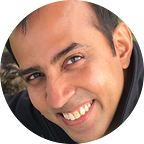Rediscovering Natural Learning
We all knew how to learn naturally but were educated out of it
By all accounts, industrial-grade curiosity has become a necessity for staying relevant professionally. In a recent post, former IBM CEO Ginny Rometty suggested some startling numbers: 43% of IBM’s open positions do not call for a traditional college diploma. Given the steadily increasing cost of four-year college and the deluge of skills-based training, you would think this is a golden time for self-learning.
Except that education and work are primarily designed to beat the curiosity out of our system. To paraphrase Sir Ken Robinson, all children are born curious; the challenge is to stay curious as we grow up.
But we learn when we have to; in times of COVID, nearly everyone has learned to bake or make a meal for themselves. These times could be the greatest push we’ve ever had in our lifetime to increase our learning capacity. I want to posit that we are all natural learners and that a few centuries of well-intentioned yet anachronistic industrial educational systems have not wiped out millennia-old learning abilities nature has embedded in us.
Drawn from my personal experience in these times (I went from wanting to cook to make a full Indian meal for friends in the space of six months) here are the four M’s of mastery in learning. The caveat is that you can apply this only to something that interests you. If finding interest is your problem, try different things until you find something that pulls you in.
Models: We learn first and foremost by watching. We want to become what we see. Watching others do what we want to, inspires us, and gives us a concrete vision of what it looks like to be successful. I started by watching episodes of Gordon Ramsay, Jamie Oliver, and Chef’s Kitchen along with a wide range of food-based documentaries, which deepened my curiosity in cooking. I simply let my interest guide what I watched. Somehow without my trying to learn, I developed a vocabulary around cooking.
Materials: Regardless of what discipline you choose, you will be shaping, crafting, or otherwise processing a material. In cooking your materials are fresh produce and proteins. Knowing and respecting your material is key for with it comes appreciation. As for me, doing a basic course in knife skills at Sur La Table made my materials look good, gave me confidence in the kitchen, and evoked a feeling of competence.
Muscle-Memory: Cooking is a sequence of smaller processes leading up to the finale of putting it all together. A lot of it is unglamorous on the surface: blanching, sautéing, braising, or broiling. Recognizing and mastering these smaller processes and repeating them regularly until you achieve predictable results is the next step in learning.
You’ve reached the messy middle where you cannot make a dish yet and you constantly feel like a failure. This is where determination and courage are needed — to not give up even though you cannot see progress. Keep at it and suddenly, without warning, you find you can put things together. I believe this is the exponential nature of the learning curve. Each cycle of practice exponentially grooves your neural pathways, so keep up the practice till you hit the upswing. The trick is to find a way to engage with the messy middle from a mediative space. The true face of learning is being fully absorbed in the routine uncaring about the goal.
Making: Finally, the moment you began learning for. You looked at your refrigerator and imagined making a delicious meal with what was available, and here you are! The irony is that when you actually do it, the moment of creation feels all too brief and anti-climatic. The best part of the learning process is invariably when you were fully absorbed in the process, uncaring of how things would turn out. Ironically, they turn out well precisely because you didn’t care about the outcome.
You can tell if the final dish will turn out well much before it is actually done by the quality of attention you attained. If you felt present and were in the flow, it will show in the quality of the dish. Your creation is a direct reflection of the quality of your attention.
So in the end, what you learn is not how to create something, but how to be fully present to the process of creating, to regulate the quality of your attention, and to work with your own nervous system. This process of learning is natural, enjoyable, and lifelong. It does not need a college degree, but it does need a person who will show you how it’s done, whether in real life or online. Whether it is creating a balance sheet, fixing a car, making a meal, or writing code, the process of learning is intrinsically the same.
Children pick up what interests them and stay immersed, even obsessed with it for days, weeks, months, even years until their interest changes. We were all children once, so rediscovering natural learning is simply retracing our steps back to that place that exists within all of us, beneath the conditioned responses programmed by society.
